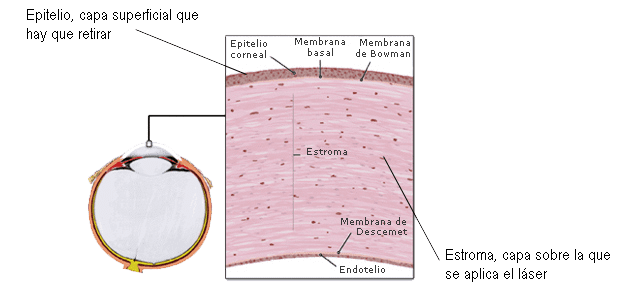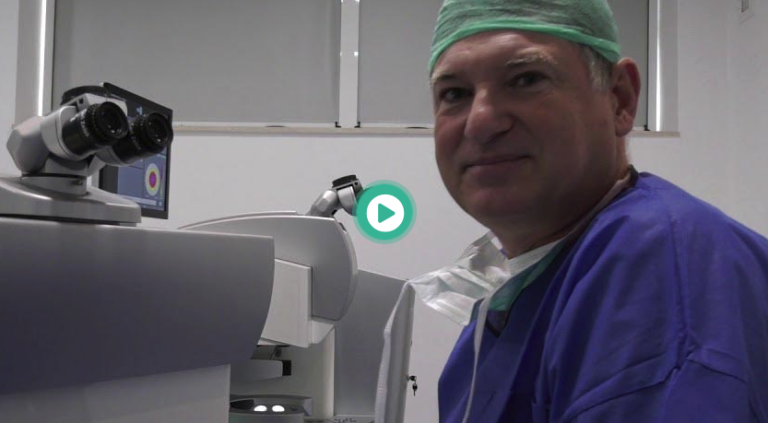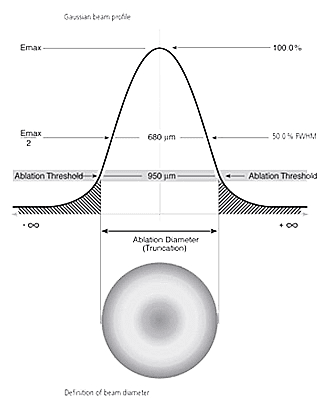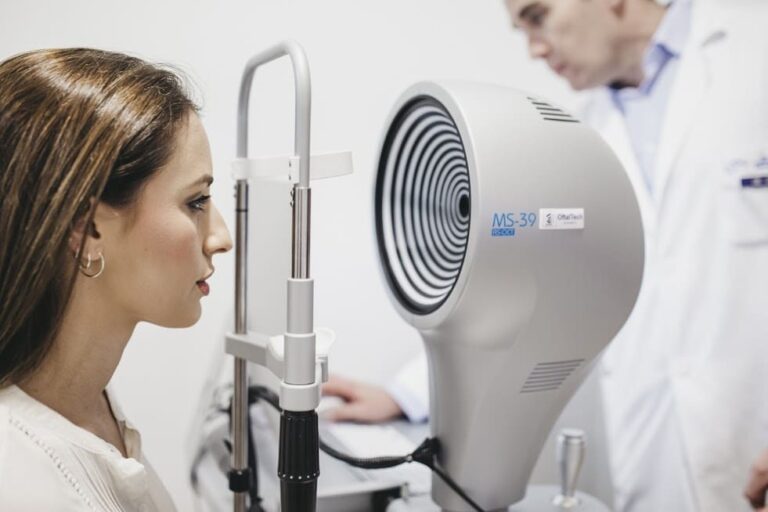Diagnostic units
Refractive Surgery Unit
Refractive Surgery
Refractive Surgery is understood as the set of surgical techniques aimed at eliminating or minimizing ocular refractive defects (such as myopia, hyperopia or astigmatism).
The image that enters the eye from the outside undergoes a process known as refraction. This image is projected onto the retina, allowing it to be transmitted to the brain and perceived clearly; this is what happens in a normal eye. However, when the eye has a refractive error (myopia, hyperopia or astigmatism), the image is projected abnormally. This implies an altered perception of the image, and therefore, blurred vision.
Myopia causes the eye to focus the image in front of the retina, and not directly on it, so the perception of the image is not sharp. In practice this implies difficulty in seeing distant objects well.
In the case of hyperopia, the image is focused behind the retina, which results in difficulty in near vision.
Astigmatism, caused by an abnormality in the curvature of the cornea, results in abnormal vision at both near and far distances.
For more than 20 years, at Clínica Ocular Dr. Tirado, we have used and developed several refractive surgery techniques to treat refractive defects.
The application of the excimer laser is nowadays the technique of first choice to correct this type of ocular defects. However, when the patient is not a candidate for excimer laser refractive surgery, there are other surgical alternatives, such as phakic lens implantation (LCI) or refractive lensectomy. A detailed analysis of the patient will allow the ophthalmologist, who is highly qualified to do so, to decide and use the most appropriate technique for your case.
REFRACTIVE PLATFORM ALCON SUITE
This platform integrates Femtosecond laser FS 200 and Laser Excimer (EX 500), the only one in Andalusia and the first one assembled in Spain with all the updated software.
Latest generation laser, which operates at 500 Hz, allowing treatments with very little trauma and in half the time of other lasers, facilitating the patient’s recovery in a few hours. It allows customized ablations, guided by topography and aberrometry.
Allows treatment of presbyopia by changing the sphericity of the cornea increasing the patient’s depth of focus, in selected cases.
The refractive suit platform, designed by the German engineering “WaveLight” is with its 500 Hz. and its 1050 Hz eye tracker, the fastest in the world and the only one with the t-cat system that allows the patient’s corneal sphericity to be modified, thus improving the quality of vision.
The laser beam, smaller than a millimeter, achieves corneal carving with micron precision and brings a new horizon in the world of refractive surgery, with a regularity in the carving that provides maximum reliability in the results obtained.
In addition, thanks to the “Eye Tracker” system, the treatment is perfectly centered on the cornea, with a computer-assisted infrared eye movement monitoring system that analyzes the position of the eye 250 times per second. That is, if the patient moves the eye during surgery, the laser head moves in coordination to avoid off-centering of the treatment. It is the laser pattern that other houses are trying to reproduce.
The integrated femtosecond laser allows to design customized flaps to the Excimer treatment to be applied, allowing larger optical areas, with exceptional visual qualities, with maximum safety for the patient.
AVEDRO CROSSLINKING SYSTEM
For combined techniques in refractive surgery and reinforcement of corneal collagen structures in case of keratoconus.
ENDOSCOPIC IMAGING SYSTEM
For the performance of endoscopic transcanalicular laser dacryocystorhinostomy. It is the newest technique for tear duct surgery. It is performed with laser through the lachrymal point, without sutures, under topical anesthesia, in joint surgery with the ENT.
What does laser eye surgery consist of?
With the laser, we correct myopia, hyperopia, astigmatism and presbyopia, modifying the curvature of the cornea. We carve the cornea to give it the curvature necessary for the eye to focus perfectly and see well in a natural way.
The cornea has several layers, being necessary to apply the laser to the central layer (stroma) to make the carving, to reach this layer, the superficial layer (epithelium) must be removed and depending on how this is done, one of the different surgical techniques explained below will be used.

Surgical technique
Lásik Technique
95% of laser eye surgery performed worldwide is done with this technique. It is very accurate, safe and allows a very quick return to normal life. We lift a superficial layer that we put back in place after applying the laser.
Lásik technique with microkeratome
It has been the most widely used technique in laser surgery. At Clinica Ocular Dr. Tirado we have performed thousands of these procedures due to their precision and safety.
With a mechanical device called microkeratome we lift a thin layer of the cornea, which we put back in place after the application of the laser, being an absolutely painless technique. Our microtome allows the thickness of the epithelial lamella to be chosen according to the thickness of each patient’s cornea. The next day the patient is living a completely normal life.
100% laser Lásik technique
With a very high precision laser (Femtosecond Laser) the superficial layer of the cornea is separated, after designing the size and shape of the flap by computer.
The accuracy in the shape, diameter and thickness of the separated layer make this technique the safest in laser eye surgery. It is so “gentle” to the eye that in a few hours normal life can be resumed. It is performed at the surgeon’s indication in cases where the use of the microkeratome is more complex. s unprecedented expansion.

Surface techniques
We only use this method when, due to corneal thickness or curvature, it is not convenient to perform LASIK. We completely remove the corneal epithelium (superficial layer of about 50 microns thick) and after the laser application we adapt a contact lens that will protect the eye during the four or five days it takes for the corneal epithelium to regenerate. (In this case it will take four or five days for the patient to have good vision and a normal life).
Clínica Ocular Dr. Tirado applies excimer laser eye surgery, mainly through the LASIK technique, with microtome or Femtosecond according to medical indications.
It is currently the fastest and most accurate technique to correct visual problems such as myopia, hyperopia or astigmatism, being the technique of choice. They are characterized by their high efficacy, safety and predictability, allowing the patient to return to work immediately.
For several years now, we have been performing all surgery in a customized manner, i.e. we apply variations of the technique adapted to the needs of the patient and the requirements of his cornea, with treatments guided by aberrometry and choosing the optical zones to be treated according to all the patient’s parameters (pupil size, target diameter, etc.). This is the only way to obtain the best results at the lowest corneal cost.
In certain cases (very small index) we choose surface techniques (LASEK or PRK), since it is more uncomfortable and delays the return to work for at least one week.
Clínica Ocular Dr. Tirado, a pioneer in this type of surgery, has a large number of highly trained professionals to advise you properly on all aspects of the intervention.

Myopia
It consists of a visual focusing error that causes difficulty in seeing distant objects, while near objects are perceived without any problem.

Astigmatism
It has its origin in the fact that the cornea does not have the same curvature in all its areas. The light is incident on several points or axes, causing blurred and distorted vision.

Hyperopia
It is a visual focusing error that causes blurred and uncomfortable near vision, although from a certain age (approximately 50 years old), distant objects are also poorly seen.
At Clínica Ocular Dr. Tirado, in addition to correcting the most common visual defects (myopia, hyperopia and astigmatism) and modifying asphericity to improve the quality of vision or focus, we apply personalized treatments, whether guided by aberrometer or topography.
Aberrometer-guided treatment
The ocular imperfections in the human eye that most affect vision are myopia, hyperopia and astigmatism, but there are other imperfections that do not affect focus, but do affect the quality of the image projected by the cornea on the retina, making vision less sharp, which are called higher order aberrations. When ocular aberrations are such that the modification of asphericity alone is not sufficient to compensate for them, we resort to the aberrometer for correction.
By correcting ocular aberrations with wavefront technology, we improve aspects such as the quality of night vision, the ability to differentiate color and brightness nuances and glare resistance.
In personalized wavefront treatment, the application of the laser is conditioned by the information obtained from the aberrometer.
The human eye is not a perfectly regular lens, whose surface would be like a billiard ball or an egg in eyes with astigmatism, but there are small irregularities that negatively affect visual quality.
In a standard correction with glasses, contact lenses or by traditional laser, the eye is taken as a perfect surface with a single prescription for its entire area of vision. With the aberrometer, we divide the optical zone of vision by analyzing 64 different areas, achieving a precise graduation of each of the subzones.
This gives us the possibility of designing a specific treatment for each eye, thus improving the quality of vision in patients in whom the nature of their ocular aberrations means that these are not adequately corrected with the modification of asphericity.
Topography-guided treatment
The corneal topographer gives us a three-dimensional image of the cornea allowing us to detect asymmetries or irregularities in its anterior and posterior faces. If these irregularities are such that vision is not good with standard correction, we use topography-guided treatment to modify the curvature of the cornea while smoothing or regularizing its surface.
Wavefront EX 500 technology, with which we work at Clínica Ocular Dr. Tirado is the latest generation in vision correction by laser surgery.

At Clínica Ocular Dr. Tirado we are able to combine optimized laser surgery (Allegretto Wave) with personalized treatment by wavefront (Allegretto Wavefront Analyzer), treatments with F-cat asphericity modification, or guided by Pentacám topographer (Topolyser) for correction of corneal irregularities, always looking for the best results for each patient.
The 500hz Allegreto EX 500 excimer laser with eye tracker at 1050, designed by the German engineering company “WaveLight”, is currently the fastest in the world, delivering 500 laser pulses of 9 mm diameter per second.
The “Eye Tracker” guidance system monitors the position of the eye at a frequency of 250 times per second thanks to infrared cameras that assist the laser computer to follow the small movements of the eye during the operation. It allows a perfect centering of the treatment. The energy it releases with each pulse makes it ideal for precisely ablating tiny portions of corneal stroma.
The femtolaser laser (FS200) acts by photodisrupting tissue. Its tiny pulses of energy pass through ocular tissues and transparent media, releasing their energy at a specific depth, dissipating the tissue and creating tiny air and carbon dioxide bubbles 2 microns in diameter. The adjacent tissue remains cold and unaltered. Its energy pulses are so short that they are measured in femtoseconds, the smallest time magnitude in existence, i.e., in billionths of a second. However, they are endowed with great energy for their tiny size.
The T-CAT treatment module, with its Custom Q customized treatments, unique in the world, allows for treatments in which, in addition to eliminating the prescription, it is possible to modify the corneal asphericity to improve the quality of vision. The optical aberration analyzer, useful both in diagnosis and assisting the laser in treatment, analyzes the refraction of the eye at 64 different points. This achieves maximum quality of vision by eliminating ocular optical aberrations and customizing the treatment for each small corneal surface area.
The Pentacam topographer takes a three-dimensional image of the cornea that allows the laser to correct any asymmetry or irregularity of the cornea, achieving a geometrically perfect corneal surface.

Do you want to have myopia surgery? Contact us.

Integrated ophthalmologic center of reference in Southern Andalusia, as a center specialized in the most modern techniques of ocular microsurgery of anterior pole, retinal surgery and refractive surgery (surgery of myopia, hyperopia and astigmatism).
Contact
- Phone: 952580817
- Email: info@clinicadrtirado.com
-
Address: Calle Méndez Núñez, 7.
Doña Sofía Park Building.
29640 Fuengirola - Málaga - City: Fuengirola - Málaga
Social networks
Schedule
- Monday: 09.00 - 21.00 h.
- Tuesday: 09.00 - 20.00 h.
- Wednesdays: 09.00 - 21.00 h.
- Thursdays: 09.00 - 21.00 h.
- Fridays: 09.00 - 20.00 h.
- Saturday: closed
- Sunday: closed